初中英语时态语态
初中英语知识点归纳时态和语态回顾
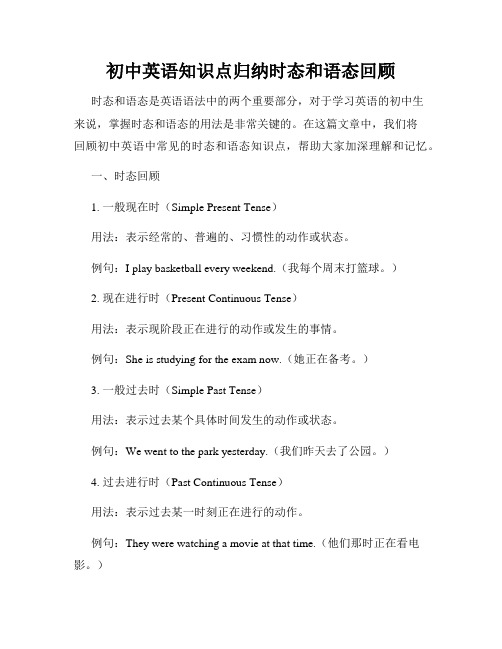
初中英语知识点归纳时态和语态回顾时态和语态是英语语法中的两个重要部分,对于学习英语的初中生来说,掌握时态和语态的用法是非常关键的。
在这篇文章中,我们将回顾初中英语中常见的时态和语态知识点,帮助大家加深理解和记忆。
一、时态回顾1. 一般现在时(Simple Present Tense)用法:表示经常的、普遍的、习惯性的动作或状态。
例句:I play basketball every weekend.(我每个周末打篮球。
)2. 现在进行时(Present Continuous Tense)用法:表示现阶段正在进行的动作或发生的事情。
例句:She is studying for the exam now.(她正在备考。
)3. 一般过去时(Simple Past Tense)用法:表示过去某个具体时间发生的动作或状态。
例句:We went to the park yesterday.(我们昨天去了公园。
)4. 过去进行时(Past Continuous Tense)用法:表示过去某一时刻正在进行的动作。
例句:They were watching a movie at that time.(他们那时正在看电影。
)5. 一般将来时(Simple Future Tense)用法:表示将来某个时间将要发生的动作或状态。
例句:I will visit my grandparents next week.(下周我会去看望我的祖父母。
)6. 将来进行时(Future Continuous Tense)用法:表示将来某一时刻正在进行的动作。
例句:They will be traveling to Beijing this time next month.(他们下个月这个时候将会在北京旅行。
)7. 现在完成时(Present Perfect Tense)用法:表示过去发生的动作对现在造成的影响或结果。
例句:He has already finished his homework.(他已经完成了作业。
初中英语的动词各种时态、语态(80张)

一般现在时的谓语构成: 1、be动词:am/is/are 2、行为动词:
A:动词原形 B:动词+-s在时
am is are are ...
I am ... he/she/it is ... we/you/they
动 单词 数第 变三 化人
称
+s
write – writes
13.The new teachers arrive (arrive) tomorrow. 14.I will have arrived (arrive) by the time the
meeting begins (begin). 15.I will tell (tell) him the news as soon as I
3. If it d_o_e_s_n_’_t_r_a_in_ (not rain) tomorrow, we’ll go to the zoo.
4. Don’t get off the bus until it_st_o(psstop). 5. You may go out to play when you
实战演练
1.Jim usually h_a_s_(have) lunch at home, but sometimes he __h_a_s_ (have) it at school.
2.I’ll tell him the news as soon as he c_o_m__e_s(come) back.
come to our party, my family will be (be)
pleased.
5、表示安排或计划好的将来动作,通 常限于表示"运动"的动词,如:go, come, leave, start等。
初中英语语态时态

• 2.Dear me! Just ________ at the time! I _______ve B.looking;had • C.look;had D.looking;have
• 答案:C • 解析:第一空应填 look, 因为这是祈使句的 谓语;第二空应填 had,因为前一句说“看 看时间吧”,这一看当然知道了现在很迟 的情形,“不知道这么迟了”显然应是 “过去”的事,故应用一般过去时态。
• 答案:D • 解析:这是由 but I don’t know whether he has finished it 这一句话的语境决定的,全句意为“史 密斯先生去年在写一本书,但我不知道他现在是 否写完了”。有的同学可能由于受 last year的影响 而误选B。但若选B,则句子前半部分的意思则变 为“史密斯先生去年写了一本书”,既然是“写 了”,那么这与下文的“但我不知道他现在是否 写完了”相矛盾。
• 答案:C • 解析:考查时间状语从句中的时态和逻辑。 当before用在It (will) be +一段时间+before 从句这一结构中时,翻译成“要不了/没有 多久就会”,本题就是这个结构,主句是 将来时,before从句中应该是一般现在时表 示将来时
• • • • • • •
答案 1—5 6—10 11—15 16—20 21—25 26---30
CDCBC DDBBC DCCDA BDADC BCBAB CCAAA
• • • • •
II 1. comes 2. bought 3. was sent 4. watering 5. serving 6. would return 7. to help 8. Is, made 9. had finished 10. been awarded
2024年初中英语知识点主动语态的16个时态详解

一、一般现在时(Simple Present Tense)一般现在时表示经常性、习惯性或普通的动作或存在的状态。
用于表示日常生活、客观事实、科学真理、历史事件等。
结构:主语+动词原形(第三人称单数在动词原形后加-s)例句:He plays basketball every day.(他每天打篮球。
)二、一般过去时(Simple Past Tense)一般过去时表示过去一些时间发生的动作或存在的状态。
用于谈论完成的动作、过去的习惯、过去的经历等。
结构:主语+一般过去时(动词过去式形式)例句:They visited the Great Wall last summer.(他们去年夏天参观了长城。
)三、一般将来时(Simple Future Tense)一般将来时表示将来一些时间将要发生的动作或存在的状态。
用于表示计划、打算、预测等含义。
结构:主语 + will + 动词原形例句:I will go to the park tomorrow.(我明天将去公园。
)四、现在进行时(Present Progressive Tense)现在进行时表示现在正在进行的动作,即表明发生在说话人说话时的动作。
结构:主语 + am/is/are + 动词-ing形式例句:She is reading a book right now.(她正在看书。
)五、过去进行时(Past Progressive Tense)过去进行时表示过去一些时间正在进行的动作,即已经开始但还没有结束的动作。
结构:主语 + was/were + 动词-ing形式例句:They were playing soccer at 4 o'clock yesterday.(他们昨天4点在踢足球。
)六、将来进行时(Future Progressive Tense)将来进行时表示将来一些时间正在进行的动作,即将来一些时刻正在进行的动作。
结构:主语 + will be + 动词-ing形式七、现在完成时(Present Perfect Tense)现在完成时表示过去发生的事情对现在造成的影响、持续到现在或者可能会再次发生的动作。
初中所有英语时态
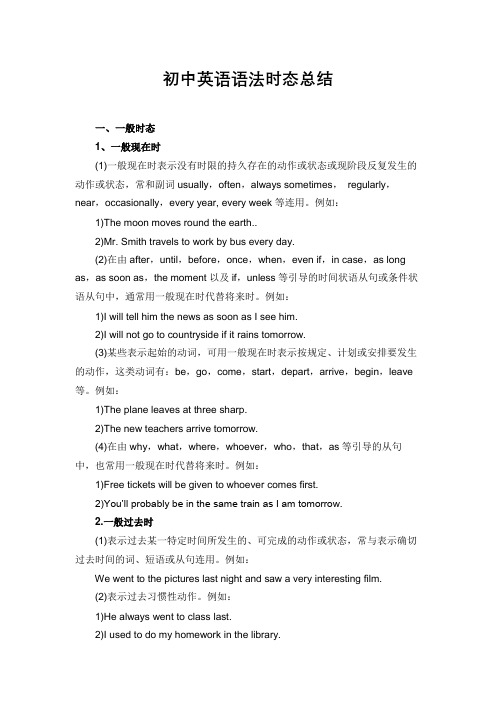
初中英语语法时态总结一、一般时态1、一般现在时(1)一般现在时表示没有时限的持久存在的动作或状态或现阶段反复发生的动作或状态,常和副词usually,often,always sometimes,regularly,near,occasionally,every year, every week等连用。
例如:1)The moon moves round the earth..2)Mr. Smith travels to work by bus every day.(2)在由after,until,before,once,when,even if,in case,as long as,as soon as,the moment以及if,unless等引导的时间状语从句或条件状语从句中,通常用一般现在时代替将来时。
例如:1)I will tell him the news as soon as I see him.2)I will not go to countryside if it rains tomorrow.(3)某些表示起始的动词,可用一般现在时表示按规定、计划或安排要发生的动作,这类动词有:be,go,come,start,depart,arrive,begin,leave 等。
例如:1)The plane leaves at three sharp.2)The new teachers arrive tomorrow.(4)在由why,what,where,whoever,who,that,as等引导的从句中,也常用一般现在时代替将来时。
例如:1)Free tickets will be given to whoever comes first.2)You’ll probably be in the same train as I am tomorrow.2.一般过去时(1)表示过去某一特定时间所发生的、可完成的动作或状态,常与表示确切过去时间的词、短语或从句连用。
【初中】英语八大时态详细汇总

现在完成时意义:He has lived here for many years.2.强调后果/影响I have read the book .结构:时间状语:(1)since 的用法Since+时间点I have lived here since 2022.一段时间+ago I have lived here since two years ago.+从句(用一般过去时)常见句型:It is + 一段时间+since从句主句(完成时)+since(一般过去时)It is seven years since I met him last time.He has learned 2000 words since he went to school.(2)For+时间段We have known each other for five years.(3)already(用于肯定句中)/yet (用与否定句或疑问句中)just/everrecently( in recent years)before never等(just now是一般过去时的时间状语)I have just finished my homework.Have you ever seen one like this?(4So far /in the past few years等,表示:“目前为止”非延续性动词延续性动词非延续性动词延续性动词Borrow Keep Fall asleep Be asleep buy have Catch a cold Have a cold leave Be away Begin/start Be ondie Be dead open Be open Come (to)Be in/at close Be closed区分Have gone to去了没回Have been to去了回来(常与次数once/twice/基数词+times连用)Have been in在某地呆了多久例句:(1)You can’t see her because he has gone to Sibo.(2)He has been to Sibo twice.(3)He has been in this city for two years.备注:Here/there/home 不与介词连用。
初中英语时态与语态考点整理

初中英语时态与语态考点整理一、协议关键信息1、一般现在时定义:表示经常发生的动作、存在的状态或习惯性的动作。
构成:主语+动词原形(当主语为第三人称单数时,动词加 s 或es)时间状语:always, usually, often, sometimes, never, everyday/week/month/year 等例句:I go to school by bike every day He often plays football after school2、一般过去时定义:表示过去某个时间发生的动作或存在的状态。
构成:主语+动词的过去式时间状语:yesterday, last week/month/year, ago, just now 等例句:I visited my grandparents last weekend We played basketball an hour ago3、一般将来时定义:表示将来要发生的动作或存在的状态。
构成:will +动词原形或 be going to +动词原形时间状语:tomorrow, next week/month/year, in the future 等例句:I will go to Beijing next month They are going to have a party tomorrow4、现在进行时定义:表示现在正在进行的动作。
构成:主语+ am/is/are +现在分词时间状语:now, at the moment 等例句:She is reading a book now They are playing football at the moment5、过去进行时定义:表示过去某个时刻正在进行的动作。
构成:主语+ was/were +现在分词时间状语:at that time, at this time yesterday 等例句:I was doing my homework at this time yesterday They were watching TV at that time6、现在完成时定义:表示过去发生的动作对现在造成的影响或结果,或过去已经开始,持续到现在的动作或状态。
初中动词的时态与语态
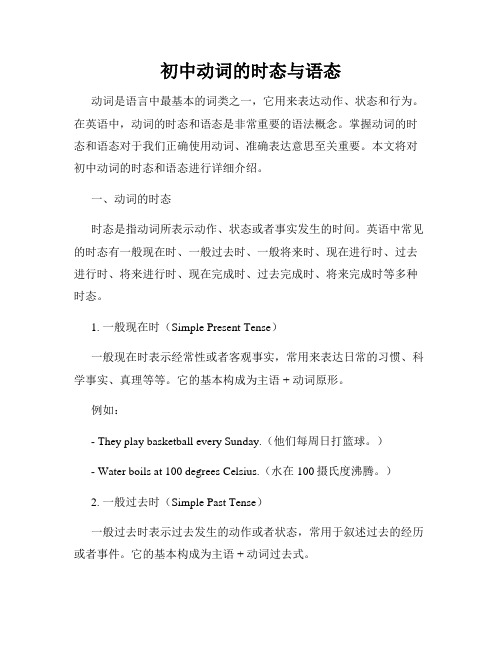
初中动词的时态与语态动词是语言中最基本的词类之一,它用来表达动作、状态和行为。
在英语中,动词的时态和语态是非常重要的语法概念。
掌握动词的时态和语态对于我们正确使用动词、准确表达意思至关重要。
本文将对初中动词的时态和语态进行详细介绍。
一、动词的时态时态是指动词所表示动作、状态或者事实发生的时间。
英语中常见的时态有一般现在时、一般过去时、一般将来时、现在进行时、过去进行时、将来进行时、现在完成时、过去完成时、将来完成时等多种时态。
1. 一般现在时(Simple Present Tense)一般现在时表示经常性或者客观事实,常用来表达日常的习惯、科学事实、真理等等。
它的基本构成为主语 + 动词原形。
例如:- They play basketball every Sunday.(他们每周日打篮球。
)- Water boils at 100 degrees Celsius.(水在100摄氏度沸腾。
)2. 一般过去时(Simple Past Tense)一般过去时表示过去发生的动作或者状态,常用于叙述过去的经历或者事件。
它的基本构成为主语 + 动词过去式。
例如:- I visited my grandparents last weekend.(我上个周末去看望了我的祖父母。
)- She didn't go to school yesterday.(她昨天没有去上学。
)3. 一般将来时(Simple Future Tense)一般将来时表示将来要发生的动作或者状态,常用于表达计划、打算、预测等等。
它的基本构成为主语 + will + 动词原形。
例如:- We will have a party next Friday.(我们下周五要举办一个聚会。
)- She won't come to the meeting tomorrow.(她明天不会来参加会议。
)4. 现在进行时(Present Continuous Tense)现在进行时表示正在进行的动作,通常用于描述当前正在发生的事情。
初中英语知识点时态总结
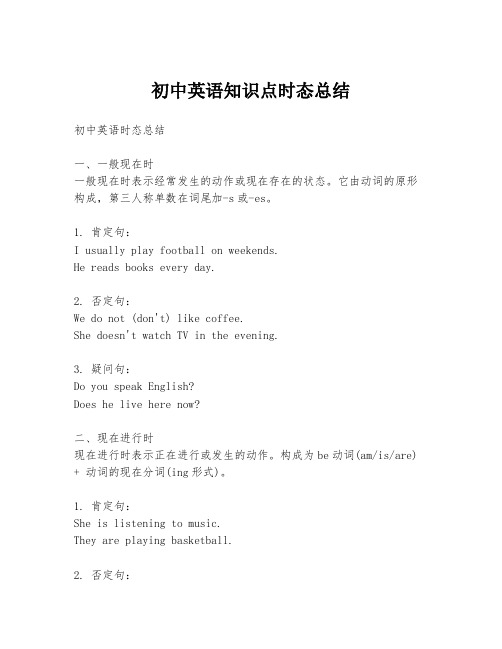
初中英语知识点时态总结初中英语时态总结一、一般现在时一般现在时表示经常发生的动作或现在存在的状态。
它由动词的原形构成,第三人称单数在词尾加-s或-es。
1. 肯定句:I usually play football on weekends.He reads books every day.2. 否定句:We do not (don't) like coffee.She doesn't watch TV in the evening.3. 疑问句:Do you speak English?Does he live here now?二、现在进行时现在进行时表示正在进行或发生的动作。
构成为be动词(am/is/are) + 动词的现在分词(ing形式)。
1. 肯定句:She is listening to music.They are playing basketball.2. 否定句:I am not (aren't) studying right now.The children are not (aren't) doing their homework.3. 疑问句:Is she cooking dinner?Are you waiting for someone?三、一般过去时一般过去时表示过去某个时间发生的动作或存在的状态。
规则动词在词尾加-ed,不规则动词则有特殊形式。
1. 肯定句:He walked to school yesterday.I visited my grandparents last week.2. 否定句:We did not (didn't) go to the cinema.She didn't buy anything at the store.3. 疑问句:Did you travel abroad last year?Did he finish his homework?四、过去进行时过去进行时表示过去某个时间点正在进行的动作。
初中英语时态语态

初中英语时态语态一、现在进行时1、表示正在进行的动作或存在的状态,常与now,look,listen等词连用。
例如:1、Look,she is reading a book.看,她正在读书。
2、My mother is cooking now.我妈妈正在做饭。
2、表示经常性、习惯性的动作,常与always,often,sometimes等词连用。
例如:1、He is always late for school.他总是上学迟到。
2、We often watch TV in the evening.我们经常在晚上看电视。
二、一般现在时1、表示通常性、规律性、习惯性的状态或动作(表示经常出现的情况)。
例如:1、She usually goes to school by bike.她通常骑自行车去上学。
2、We have Chinese four times a week.我们一周上四次语文课。
2、表示客观事实或普遍真理。
例如:1、The earth is round.地球是圆的。
2、The sun rises in the east and sets in the west.太阳从东方升起,从西方落下。
三、一般过去时1、表示在过去某个时间发生的动作或存在的状态。
例如:1、We had a party last night.我们昨晚举行了一个聚会。
2、He was born in 1990.他出生于1990年。
2、表示过去的经常性、习惯性的动作。
例如:1、He usually walked to school.他通常步行上学。
2、We often watched TV in the evening.我们经常在晚上看电视。
一、时态时态是英语语法中的重要组成部分,它表示动作发生的时间和方式。
初中生需要掌握的时态包括一般现在时、现在进行时、一般将来时和一般过去时。
1、一般现在时一般现在时表示经常发生的动作或存在的状态。
初中英语八大时态和语态
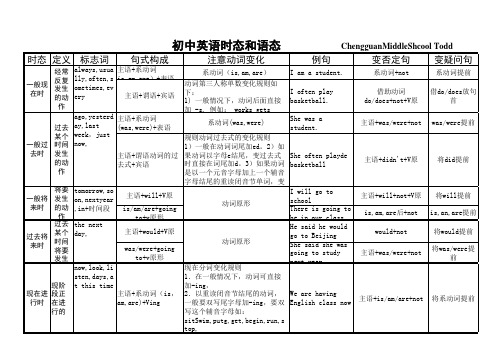
sitSwim,putg,get,begin,run,s
top,
系动词+not 借助动词 do/does+not+V原 主语+was/were+not
主语+didn't+V原
主语+will+not+V原 is,am,are后+not
would+not 主语+was/were+not
主语+is/am/are+not
the next day,
now,look,li
to+v原形 主语+would+V原
was/were+going to+v原形
动词原形 现在分词变化规则
be in our class
He said he would go to Beijing She said she was going to study next year
has / have + been + been
及物动词的过去分词 translated
has / have + been + +being+及物动词的过 去分词
iAntloetmtaenryhas been being written by Twohmen the song
had+ been + 及物动 had been
字母结尾的重读闭音节单词,变
将要 tomorrow,so 一般将 发生 on,nextyear 来时 的动 ,in+时间段
主语+will+V原 is/am/are+going
初中英语的动词时态主要有五种
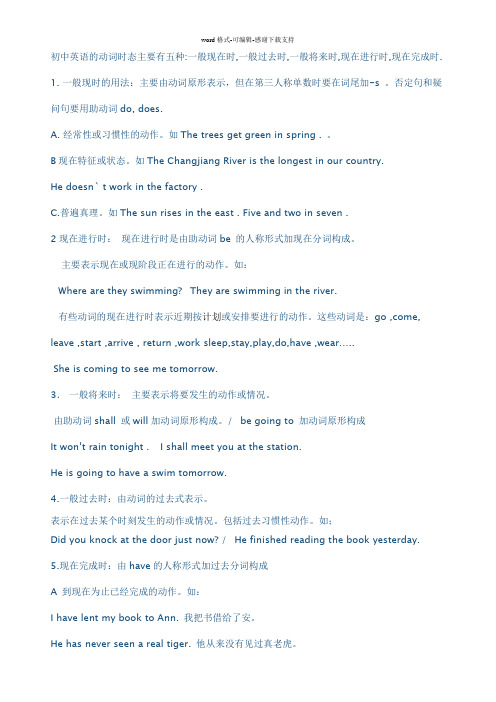
初中英语的动词时态主要有五种:一般现在时,一般过去时,一般将来时,现在进行时,现在完成时.1. 一般现时的用法:主要由动词原形表示,但在第三人称单数时要在词尾加-s 。
否定句和疑问句要用助动词do, does.A. 经常性或习惯性的动作。
如The trees get green in spring . 。
B现在特征或状态。
如The Changjiang River is the longest in our country.He doesn` t work in the factory .C.普遍真理。
如The sun rises in the east . Five and two in seven .2现在进行时:现在进行时是由助动词be 的人称形式加现在分词构成。
主要表示现在或现阶段正在进行的动作。
如:Where are they swimming? They are swimming in the river.有些动词的现在进行时表示近期按计划或安排要进行的动作。
这些动词是:go ,come, leave ,start ,arrive , return ,work sleep,stay,play,do,have ,wear…..She is coming to see me tomorrow.3.一般将来时:主要表示将要发生的动作或情况。
由助动词shall 或will加动词原形构成。
/ be going to 加动词原形构成It won’t rain tonight .I shall meet you at the station.He is going to have a swim tomorrow.4.一般过去时:由动词的过去式表示。
表示在过去某个时刻发生的动作或情况。
包括过去习惯性动作。
如;Did you knock at the door just now? / He finished reading the book yesterday.5.现在完成时:由have的人称形式加过去分词构成A 到现在为止已经完成的动作。
(完备版)初中英语动词时态和语态解读
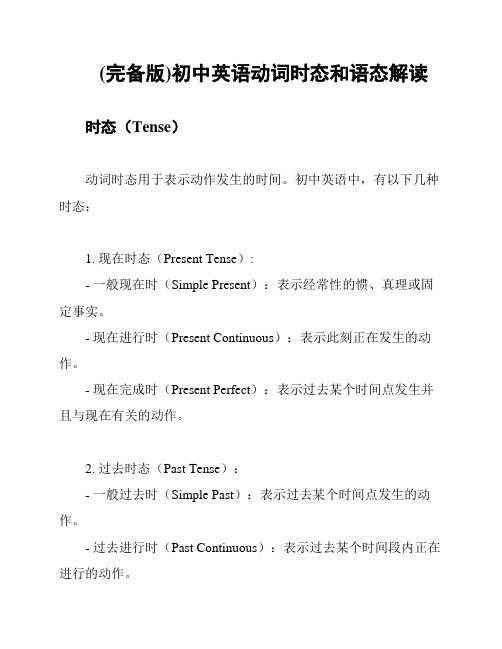
(完备版)初中英语动词时态和语态解读时态(Tense)动词时态用于表示动作发生的时间。
初中英语中,有以下几种时态:1. 现在时态(Present Tense):- 一般现在时(Simple Present):表示经常性的惯、真理或固定事实。
- 现在进行时(Present Continuous):表示此刻正在发生的动作。
- 现在完成时(Present Perfect):表示过去某个时间点发生并且与现在有关的动作。
2. 过去时态(Past Tense):- 一般过去时(Simple Past):表示过去某个时间点发生的动作。
- 过去进行时(Past Continuous):表示过去某个时间段内正在进行的动作。
- 过去完成时(Past Perfect):表示过去某个时间点之前已经完成的动作。
3. 将来时态(Future Tense):- 一般将来时(Simple Future):表示将来会发生的动作。
- 将来进行时(Future Continuous):表示将来某个时间段内正在进行的动作。
- 将来完成时(Future Perfect):表示将来某个时间点之前已经完成的动作。
语态(Voice)语态用于表示句子的主语是动作的执行者还是承受者。
初中英语中主要有以下两种语态:1. 主动语态(Active Voice):主语是动作的执行者,强调动作的主动性。
2. 被动语态(Passive Voice):主语是动作的承受者,强调动作的受事性。
时态和语态的变化在不同的时态和语态下,动词的形式会有所变化。
以下是一些常见时态和语态的变化规律:- 一般现在时的变化:- 主动语态:动词原形,例如:I eat an apple.- 被动语态:be动词(am/is/are) + 动词的过去分词,例如:An apple is eaten by me.- 一般过去时的变化:- 主动语态:动词过去式,例如:I ate an apple.- 被动语态:be动词的过去式(was/were)+ 动词的过去分词,例如:An apple was eaten by me.- 一般将来时的变化:- 主动语态:will + 动词原形,例如:I will eat an apple.- 被动语态:will + be动词(am/is/are) + 动词的过去分词,例如:An apple will be eaten by me.以上仅为部分时态和语态的变化规律,根据实际需要和句子结构,动词的形式有可能会有更多的变化。
初中英语时态语态

初中英语时态语态初中英语时态语态的学习与应用初中英语时态语态是英语学习的重要组成部分。
掌握好时态和语态的用法对于英语表达和理解具有重要意义。
本文将介绍常用的英语时态和语态及其用法,帮助初中生更好地掌握英语语言规则。
一、英语时态英语时态是表示动作或状态发生的时间和方式的语法形式。
以下是初中英语常用的时态及其用法:1、现在简单时(Simple Present Tense):用于描述经常发生的动作或存在的状态,如“I eat an apple every day”中的“eat”。
2、现在进行时(Present Continuous Tense):用于描述正在进行的动作或状态,如“I am eating an apple”中的“am eating”。
3、现在完成时(Present Perfect Tense):用于描述已经完成的动作或状态,如“I have eaten an apple”中的“have eaten”。
4、现在完成进行时(Present Perfect Continuous Tense):用于描述在过去某一时间点开始的动作或状态,如“I have been eating an apple”中的“have been eating”。
5、过去简单时(Simple Past Tense):用于描述过去发生的动作或状态,如“She walked to the park yesterday”中的“walked”。
6、过去进行时(Past Continuous Tense):用于描述过去某个时间点正在进行的动作或状态,如“She was walking to the park at 3 o'clock yesterday”中的“was walking”。
7、过去完成时(Past Perfect Tense):用于描述在过去某一时间点之前已经完成的动作或状态,如“She had finished her homework before dinner”中的“had finished”。
七年级英语时态语态详解
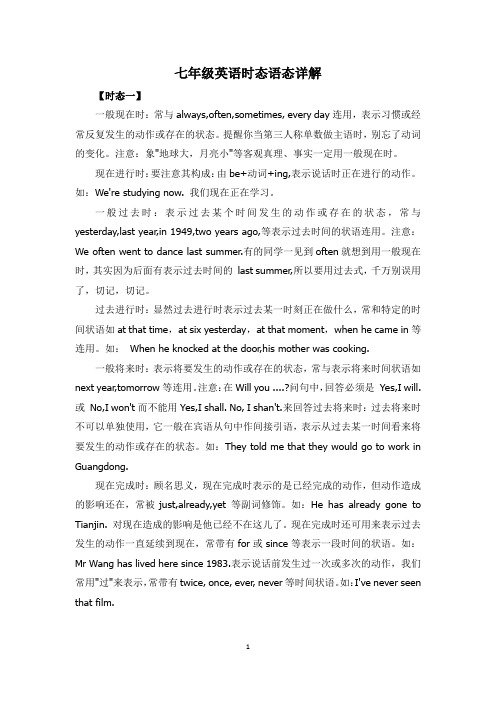
七年级英语时态语态详解【时态一】一般现在时:常与always,often,sometimes, every day连用,表示习惯或经常反复发生的动作或存在的状态。
提醒你当第三人称单数做主语时,别忘了动词的变化。
注意:象"地球大,月亮小"等客观真理、事实一定用一般现在时。
现在进行时:要注意其构成:由be+动词+ing,表示说话时正在进行的动作。
如:We're studying now. 我们现在正在学习。
一般过去时:表示过去某个时间发生的动作或存在的状态,常与yesterday,last year,in 1949,two years ago,等表示过去时间的状语连用。
注意:We often went to dance last summer.有的同学一见到often就想到用一般现在时,其实因为后面有表示过去时间的last summer,所以要用过去式,千万别误用了,切记,切记。
过去进行时:显然过去进行时表示过去某一时刻正在做什么,常和特定的时间状语如at that time,at six yesterday,at that moment,when he came in等连用。
如:When he knocked at the door,his mother was cooking.一般将来时:表示将要发生的动作或存在的状态,常与表示将来时间状语如next year,tomorrow等连用。
注意:在Will you ....?问句中,回答必须是Yes,I will.或No,I won't而不能用Yes,I shall. No, I shan't.来回答过去将来时:过去将来时不可以单独使用,它一般在宾语从句中作间接引语,表示从过去某一时间看来将要发生的动作或存在的状态。
如:They told me that they would go to work in Guangdong.现在完成时:顾名思义,现在完成时表示的是已经完成的动作,但动作造成的影响还在,常被just,already,yet 等副词修饰。
初中英语知识点归纳动词的时态和语态变化规则
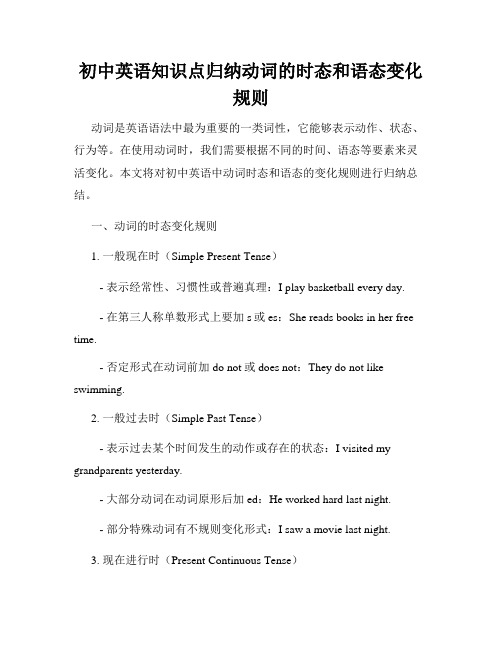
初中英语知识点归纳动词的时态和语态变化规则动词是英语语法中最为重要的一类词性,它能够表示动作、状态、行为等。
在使用动词时,我们需要根据不同的时间、语态等要素来灵活变化。
本文将对初中英语中动词时态和语态的变化规则进行归纳总结。
一、动词的时态变化规则1. 一般现在时(Simple Present Tense)- 表示经常性、习惯性或普遍真理:I play basketball every day.- 在第三人称单数形式上要加s或es:She reads books in her free time.- 否定形式在动词前加do not或does not:They do not like swimming.2. 一般过去时(Simple Past Tense)- 表示过去某个时间发生的动作或存在的状态:I visited my grandparents yesterday.- 大部分动词在动词原形后加ed:He worked hard last night.- 部分特殊动词有不规则变化形式:I saw a movie last night.3. 现在进行时(Present Continuous Tense)- 表示现在正在进行的动作:She is watching TV now.- 动词be的不同形式变化 + 现在分词形式进行时态构成:They are playing football in the park.4. 过去进行时(Past Continuous Tense)- 表示过去某段时间内正在进行的动作:He was studying when I called him.- 动词be的过去式 + 现在分词形式构成过去进行时态:They were playing chess last night.5. 现在完成时(Present Perfect Tense)- 表示发生在过去,但对现在有影响或结果的动作或状态:I have finished my homework.- 助动词have/has + 过去分词形式构成现在完成时态:He has lived in London for five years.6. 过去完成时(Past Perfect Tense)- 表示过去某一时间或动作之前已经发生的动作:She had already left when I arrived.- had + 过去分词形式构成过去完成时态:They had studied English for three years before they went abroad.7. 一般将来时(Simple Future Tense)- 表示将来某个时间将要发生的动作:They will have a meeting tomorrow.- 助动词will + 动词原形构成一般将来时态:I will send you the email later.8. 过去将来时(Future in the Past Tense)- 表示过去某个时间将要发生的动作:He said he would visit us the next day.- 助动词would + 动词原形构成过去将来时态:She told me she would help me with my homework.二、动词的语态变化规则1. 主动语态(Active Voice)- 句子的主语是动作的执行者:I write a letter.2. 被动语态(Passive Voice)- 句子的主语是动作的承受者,动作的执行者通常被省略:The letter is written by me.- 助动词be + 过去分词形式构成被动语态:The book was borrowed from the library.总结:初中英语中,动词的时态和语态变化规则是我们学习和掌握动词的重要内容。
初中英语时态一览表

初中英语时态一览表以下是初中英语主要时态的一览表:1. 现在一般时:I eat an apple every day.2. 过去一般时:She studied English last year.3. 现在进行时:They are playing basketball now.4. 过去进行时:They were having dinner at this time yesterday.5. 现在完成时:I have finished my homework.6. 过去完成时:They had learned 2000 English words by the end of last year.7. 现在完成进行时:We have been waiting for you for half an hour.8. 过去完成进行时:We had been learning English for 3 years by the end of last year.9. 将来一般时:She will visit her grandparents next week.10. 将来进行时:They will be having a meeting tomorrow.11. 将来完成时:They will have finished their work by the end of this week.12. 过去将来一般时:He said he would go to the library the next day.13. 过去将来进行时:He said he would be working on his project over the weekend.14. 过去将来完成时:He said he would have written the report by the end of the month.希望这个一览表能帮到你!如果你还有其他问题,请随时提问。
初中英语时态与语态的综合练习与考点总结
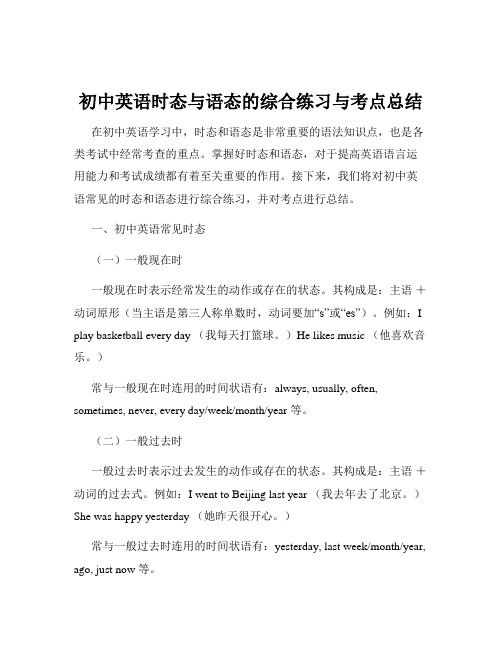
初中英语时态与语态的综合练习与考点总结在初中英语学习中,时态和语态是非常重要的语法知识点,也是各类考试中经常考查的重点。
掌握好时态和语态,对于提高英语语言运用能力和考试成绩都有着至关重要的作用。
接下来,我们将对初中英语常见的时态和语态进行综合练习,并对考点进行总结。
一、初中英语常见时态(一)一般现在时一般现在时表示经常发生的动作或存在的状态。
其构成是:主语+动词原形(当主语是第三人称单数时,动词要加“s”或“es”)。
例如:I play basketball every day (我每天打篮球。
)He likes music (他喜欢音乐。
)常与一般现在时连用的时间状语有:always, usually, often, sometimes, never, every day/week/month/year 等。
(二)一般过去时一般过去时表示过去发生的动作或存在的状态。
其构成是:主语+动词的过去式。
例如:I went to Beijing last year (我去年去了北京。
)She was happy yesterday (她昨天很开心。
)常与一般过去时连用的时间状语有:yesterday, last week/month/year, ago, just now 等。
(三)一般将来时一般将来时表示将来要发生的动作或存在的状态。
其构成有多种形式,常见的有:will +动词原形;be going to +动词原形。
例如:I will visit my grandparents next week (我下周将去看望我的祖父母。
)She is going to have a party tomorrow (她明天将举办一个聚会。
)常与一般将来时连用的时间状语有:tomorrow, nextweek/month/year, in the future 等。
(四)现在进行时现在进行时表示正在进行的动作。
其构成是:主语+ be 动词(am/is/are)+动词的现在分词。
(详细解析)初中英语动词时态和语态讲解
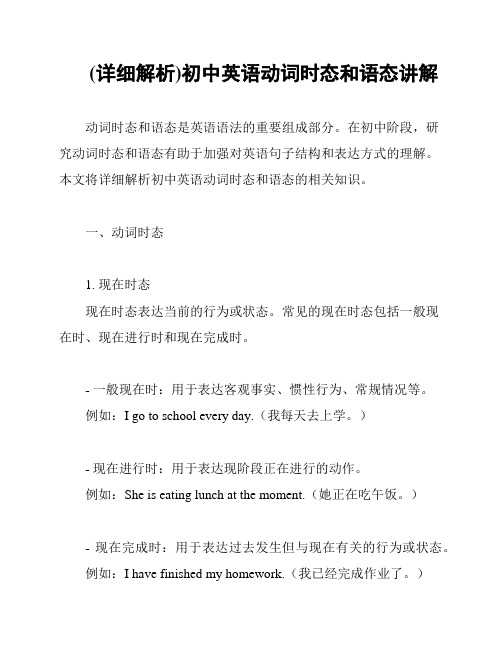
(详细解析)初中英语动词时态和语态讲解动词时态和语态是英语语法的重要组成部分。
在初中阶段,研究动词时态和语态有助于加强对英语句子结构和表达方式的理解。
本文将详细解析初中英语动词时态和语态的相关知识。
一、动词时态1. 现在时态现在时态表达当前的行为或状态。
常见的现在时态包括一般现在时、现在进行时和现在完成时。
- 一般现在时:用于表达客观事实、惯性行为、常规情况等。
例如:I go to school every day.(我每天去上学。
)- 现在进行时:用于表达现阶段正在进行的动作。
例如:She is eating lunch at the moment.(她正在吃午饭。
)- 现在完成时:用于表达过去发生但与现在有关的行为或状态。
例如:I have finished my homework.(我已经完成作业了。
)2. 过去时态过去时态用于表达已经发生的动作或状态。
常见的过去时态包括一般过去时、过去进行时和过去完成时。
- 一般过去时:用于表达过去某个时间发生的动作。
例如:He visited his grandparents last weekend.(他上周末去看望了他的祖父母。
)- 过去进行时:用于表达过去某个时间正在进行的动作。
例如:They were playing soccer when it started raining.(当下雨开始时,他们正在踢足球。
)- 过去完成时:用于表达过去发生并完成的行为或状态。
例如:She had already left when I arrived.(当我到达时,她已经离开了。
)3. 将来时态将来时态用于表达将来发生的动作或状态。
常见的将来时态包括一般将来时、将来进行时和将来完成时。
- 一般将来时:用于表达将来某个时间要发生的动作。
例如:I will go to the cinema tomorrow.(我明天要去电影院。
)- 将来进行时:用于表达将来某个时间正在进行的动作。
- 1、下载文档前请自行甄别文档内容的完整性,平台不提供额外的编辑、内容补充、找答案等附加服务。
- 2、"仅部分预览"的文档,不可在线预览部分如存在完整性等问题,可反馈申请退款(可完整预览的文档不适用该条件!)。
- 3、如文档侵犯您的权益,请联系客服反馈,我们会尽快为您处理(人工客服工作时间:9:00-18:30)。
九种时态的具体用法:一、一般现在时表示现阶段经常或习惯发生的动作或存在的状态,或说明主语的特征。
①一般现在时句子中常有的时状: often , usually , sometimes, always, every (day等), once/twice a (week等), on (Sunday等), never, in the (morning等)。
如:They go to the Palace Museum once a year.(他们每年去一次故宫)/ They often discuss business in the evening.(他们经常在晚上商谈生意)②表示客观真理、事实、人的技能或现在的状态时句子里一般不用时间状语。
如:The earth turns round the sun.(地球绕着太阳转)/Light travels faster than sound.(光传播比声音快)③表示十分确定会发生(如安排好的事情)或按照时间表进行的事情,用一般现在可以表达将来,句子中可以有将来时间。
如:The train for Haikou leaves at 8:00 in the morning.(开往汉口的列车上午8点开车)④在时间状语从句中(以when, after, before, while, until, as soon as等引导)和条件状语从句中(以if,unless引导),用一般现在时代替一般将来时,句子可以有将来时间。
如:Please ring me up as soon as you arrive in Germany.(你一到德国就给我打电话) / If it rains tomorrow,we will have to stay at home.(如果明天下雨我们就只好呆在家)⑤一般现在时用于倒装句中可以表示正在发生的动作,动词以come, go为主。
如:Here comes the bus. (车来了) / There goes the bell.(铃响了)。
⑥一般现在时常用于体育比赛的解说或寓言故事中。
Now the midfield player catches the ball and he keeps it.⑦人的心理活动和感官动作一般用一般现在时而不用现在进行时表达,常见动词有:like, love, hate, dislike, want, wish, hope, think(认为),understand, remember, forget, mean, need, hear, feel, see.如:I think it is going to snow.(我想天要下雪了)/I really hope you can enjoy your stay here.(我真的希望你愉快地呆在这儿)二、一般过去时表示过去某时发生的动作或状态,这种动作或状态可能是一次性,也可能经常发生。
①表示过去具体时刻发生的一次性动作时,时间状语有:yesterday ,ago,when引导的时间状语从句。
如:I got up at 6:00 this morning.(我是早上六点钟起床的)/Little Tom broke the window at half past nine this morning.(小汤姆今天早上九点半把窗子打破了)/When he went into the room,he saw a stranger talking with his father.(他走进房间时发现一个陌生人正和他父亲谈话)②表示过去一段时间内不知何时发生的一次性动作时,时间状语有:yesterday,last (year等), in (1998 等)。
如:He came to our city in the year 2000.(他2000年来到我们市)③表示过去一个阶段中经常发生的事情时,时间状语有:last…, in…,from…to…, for(10 years),often,usually, sometimes, always, never等。
如:Mr Jackson usually went to evening schools when he was young. / Every day he went to the rich man and borrowed books from him.④讲故事、对过去经历的回忆、双方都明白的过去事件等一般用过去时,而且经常省略时间状语。
如:I happened to meet Rose in the street.(我正好在街上遇到露西)三、一般将来时表示将来某一时刻或经常发生的动作或状态。
①一般将来时的时间状语有:tomorrow,this (afternoon),next (year),oneday,now,soon, someday,sometime, in the future, when引导的从句等。
②用will构成的将来时,表示动作与人的主观愿望无关。
“shall”用于第一人称,“will” 用于所有人称。
如:I will graduate from this school soon.(我很快就要从这所中学毕业了)/ You will stay alone after I leave.(我走了之后你就要一个人过了)③“am/is/are going to+动词原形”表示打算或准备要做的事情,或者主观判断即将要发生的事情,而“am/is/are to +动词原形”表示安排或计划中的动作。
如:A man told them that the woman was to give birth to the special baby.(有一个人告诉他们那个妇女就会生下那个特别的男孩)/It’s going to rain soon.(天快要下雨了)④表示一个人临时决定要做某事,可以用will表达。
如:I will go to the lab to get some chemicals(化学药剂). So please wait until I return.(我要到化学实验室去取些药品,请等我回头)⑤现在进行时、一般现在时也可以表示将来。
(见相应时态)⑥“be to +动词原形”表示按照计划将要发生的事情。
如:An angel came to tellher that she was to have this special boy.四、现在进行时现在进行时表示现在正在进行的动作或是现阶段正发生而此刻不一定在进行的动作。
①现在进行时由“助动词be (am is are ) +现在分词”构成。
②现在进行时的时间状语有:now, this …, these…等,但经常不用。
如:What are you doing up in the tree?(你在树上干什么?)/I am writing a long novel these days.(我最近在写一本长篇小说)③表示即将发生的动作,一般指近期安排好的事情。
常见的动词有:come, go,stay, leave, spend, do等。
如:I’m coming now.(我就来)/What are you doing tomorrow?(你明天干什么?)/He is leaving soon.(他就要走了)④表示频繁发生或反复进行的动作,常与always等频度副词连用,以表示赞扬、不满或讨厌等感情色彩。
如:He is always borrowing money from me and forgetting all about it some time later.(他老是向我借钱,过一些时候就忘得一干二净)五、过去进行时过去进行时表示过去某一时刻或某阶段正在进行的动作。
①过去进行时由“was(第一、三人称单数)或were(第二人称单数和各人称的复数)+现在分词”构成。
②过去进行时的时间状语有:then, at that time, this time yesterday, at (eight)yesterday (morning),(a year) ago, 以及由when引出的时间状语从句。
如:He was cooking supper this time yesterday.(昨天这个时候他正在做晚饭)/ The little girl was playing with her toy when I saw her.(我看到小女孩的时候她正在玩玩具)③用于宾语从句或时间状语从句中,表示与主句动作同时进行而且是延续时间较长。
句子中通常不用时间状语。
如:She was it happen when she was walking past.(她路过时看到事情的发生)/ They sang a lot of songs while they were walking in the dark forest.(他们在黑暗的森林里走时唱了很多歌)④也可以表示过去一个阶段频繁发生或反复进行的动作,常与always等频度副词连用,以表示赞扬、不满或讨厌等感情色彩。
如:He was always borrowing money from me when he lived here.(他住在这里时老向我借钱)六、现在完成时现在完成时表示一个发生在过去的、对现在仍有影响的动作,或表示开始在过去,并且一直延续到现在,甚至还可能延续下去的动作。
①在完成时由“助动词have (has)+动词的过去分词”构成。
②表示发生在过去的对现在仍有影响的动作时,时间状语有:already, yet, just, once, twice,ever, never,three times, before等。
如:I have never seen such fine pictures before. (我以前从来没有看过这么好的画)/ He has just gone to England.(他刚去英国)③表示在过去开始一直延续到现在(可能延续下去)的动作或状态时,时间状语有:for (two years),since 1990, since (two weeks ago)和since引导的状语从句。
如:I have been away from my hometown for thirty years.(我离开家乡有30年了)/ Uncle Wang has worked in the factory since it opened.(自从这家工厂开张,王叔叔一直在那儿工作)④have been to与have gone to的区别:have gone to(“已经去了”)表示人不在这里,have been to(“去过”)表示人在这里。
